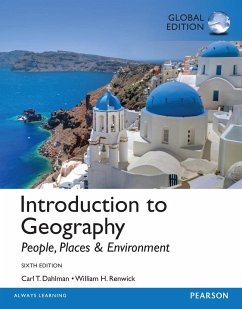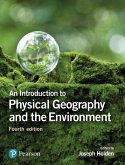Introduction to Geography: People, Places, & Environment, Sixth Edition introduces students to the major tools, techniques, and methodological approaches of the discipline through new applied and visual features that engage students and reinforce real-world connections. The authors emphasize the integration of various aspects of geographic processes and systems by discussing what happens in one set of geographic processes and how that affects others. For example, what happens in economic systems affects environmental conditions; what happens to climate affects political dynamics. Features + Benefits
An emphasis on current applied topics and critical thinking includes:
NEW Explorations. Written by guest contributors who are experts in their respective fields, these new features help students make the link between geographical concepts from the chapters’ major themes to real-world data and research, showing the applied nature and relevance of geography today.
NEW The World in 2050. These new features, located at the end of each chapter, extrapolate current trends and predictions of key geographic issues into the future, using current data and a highly visual approach to discuss possible future scenarios.
Rapid Change. These features emphasize the issues that arise as local places contend with environmental, economic, cultural, and political changes that occur at unprecedented speed.
Global and Local. More than any other discipline, geography explains the connections between global forces and local places. Global and Local features examine in detail how particular places respond to global impacts.
Thinking Geographically. These critical thinking questions encourage higher level thinking and exploration beyond the text, into the library or out into the community. Some students may find these questions appropriate for papers or research projects.
Ample teaching and learning aids include:
A Look Ahead. Each chapter begins with a brief outline of the main points to be made in the chapter
NEW Learning Outcomes help students prioritize the major learning goals, skills, and knowledge in the chapter.
NEW Checkpoint questions integrated throughout the chapter allow the students to check their understanding of the material just studied.
Opening Vignette. A story and related photo begin each chapter, detailing real-world questions and problems that arise from the material discussed in that chapter.
Key Terms. The key terms in each chapter are printed in boldface when each is introduced, and listed alphabetically at the end of chapter. A back of book glossary provides definitions for each key term.
Summary. Each chapter closes with a brief summary of its main points.
Review and Discussion Questions. These give students the opportunity to test their reading comprehension on their own for self study, as assigned homework, or in group work for collaborative learning during discussion sections.
Up-to-date coverage incorporates the recent global financial crisis, current environmental impacts and concerns, extensive discussion of global climate change, the carbon cycle, data from the 2010 U.S. Census and the 2013 Population Reference Bureau’s Population Data, and the latest techniques in geospatial technologies, and updates within every discussion as appropriate
The authors explore the forces at work behind the maps to help students understand maps of economic or cultural activity more deeply by emphasizing:
the interrelationships between humans and their environment.
that Geography can be studied close to home.
the dynamic nature of modern Geography.
Geographic concepts are applied to help students understand contemporary issues. Each chapter strives specifically to connect the geographic concepts under discussion to understanding the issues of the day.
The rich and diverse cartographic, photo, and illustration program:
highlights important spatial relationships.
features many different maps and illustrations, all designed to provide the best clarity of the concept at hand to beginning students.
Coverage of modern geographic tools is integrated throughout. With the rapid explosion of GPS, GIS, and remote sensed imagery, geospatial technologies are quickly evolving, and have become part of our daily lives. Today, maps are drawn and updated rapidly using geographic information systems (GIS) and digital cartographic tools. GIS have become essential and ubiquitous on geographers’ desks, and their importance is clear in this book. Discussion of GIS and other geospatial technology is included in Chapter 1, and the use of GIS in geographic problem-solving is illustrated throughout.
1. Introduction to Geography
Part 1: Environment and Resources
2. Landforms
3. Weather, Climate & Climate Change
4. Biosphere
5. Earth’s Resources and Environmental Protection
Part 2: Culture
6. Population and Migration
7. Cultural Geography
8. Languages and Religions
9. Food and Agriculture
Part 3: Development of Modern Society
10. Cities and Urbanization
11. A World of States
12. Economy and Development
Basic Approach Introduction to Geography: People, Places, & Environment, Sixth Edition introduces students to the major tools, techniques, and methodological approaches of the discipline through new applied and visual features that engage students and reinforce real-world connections. The authors emphasize the integration of various aspects of geographic processes and systems by discussing what happens in one set of geographic processes and how that affects others. For example, what happens in economic systems affects environmental conditions; what happens to climate affects political dynamics. Features An emphasis on current applied topics and critical thinking includes: * NEW Explorations. Written by guest contributors who are experts in their respective fields, these new features help students make the link between geographical concepts from the chapters' major themes to real-world data and research, showing the applied nature and relevance of geography today. * NEW The World in 2050. These new features, located at the end of each chapter, extrapolate current trends and predictions of key geographic issues into the future, using current data and a highly visual approach to discuss possible future scenarios. * Rapid Change. These features emphasize the issues that arise as local places contend with environmental, economic, cultural, and political changes that occur at unprecedented speed. * Global and Local. More than any other discipline, geography explains the connections between global forces and local places. Global and Local features examine in detail how particular places respond to global impacts. * Thinking Geographically. These critical thinking questions encourage higher level thinking and exploration beyond the text, into the library or out into the community. Some students may find these questions appropriate for papers or research projects. Ample teaching and learning aids include: * A Look Ahead. Each chapter begins with a brief outline of the main points to be made in the chapter * NEW Learning Outcomes help students prioritize the major learning goals, skills, and knowledge in the chapter. * NEW Checkpoint questions integrated throughout the chapter allow the students to check their understanding of the material just studied. * Opening Vignette. A story and related photo begin each chapter, detailing real-world questions and problems that arise from the material discussed in that chapter. * Key Terms. The key terms in each chapter are printed in boldface when each is introduced, and listed alphabetically at the end of chapter. A back of book glossary provides definitions for each key term. * Summary. Each chapter closes with a brief summary of its main points. * Review and Discussion Questions. These give students the opportunity to test their reading comprehension on their own for self study, as assigned homework, or in group work for collaborative learning during discussion sections. * Up-to-date coverage incorporates the recent global financial crisis, current environmental impacts and concerns, extensive discussion of global climate change, the carbon cycle, data from the 2010 U.S. Census and the 2013 Population Reference Bureau's Population Data, and the latest techniques in geospatial technologies, and updates within every discussion as appropriate The authors explore the forces at work behind the maps to help students understand maps of economic or cultural activity more deeply by emphasizing: * the interrelationships between humans and their environment. * that Geography can be studied close to home. * the dynamic nature of modern Geography. Geographic concepts are applied to help students understand contemporary issues. Each chapter strives specifically to connect the geographic concepts under discussion to understanding the issues of the day. The rich and diverse cartographic, photo, and illustration program: * highlights important spatial relationships. * features many different maps and illustrations, all designed to provide the best clarity of the concept at hand to beginning students. Coverage of modern geographic tools is integrated throughout. With the rapid explosion of GPS, GIS, and remote sensed imagery, geospatial technologies are quickly evolving, and have become part of our daily lives. Today, maps are drawn and updated rapidly using geographic information systems (GIS) and digital cartographic tools. GIS have become essential and ubiquitous on geographers' desks, and their importance is clear in this book. Discussion of GIS and other geospatial technology is included in Chapter 1, and the use of GIS in geographic problem-solving is illustrated throughout.
An emphasis on current applied topics and critical thinking includes:
NEW Explorations. Written by guest contributors who are experts in their respective fields, these new features help students make the link between geographical concepts from the chapters’ major themes to real-world data and research, showing the applied nature and relevance of geography today.
NEW The World in 2050. These new features, located at the end of each chapter, extrapolate current trends and predictions of key geographic issues into the future, using current data and a highly visual approach to discuss possible future scenarios.
Rapid Change. These features emphasize the issues that arise as local places contend with environmental, economic, cultural, and political changes that occur at unprecedented speed.
Global and Local. More than any other discipline, geography explains the connections between global forces and local places. Global and Local features examine in detail how particular places respond to global impacts.
Thinking Geographically. These critical thinking questions encourage higher level thinking and exploration beyond the text, into the library or out into the community. Some students may find these questions appropriate for papers or research projects.
Ample teaching and learning aids include:
A Look Ahead. Each chapter begins with a brief outline of the main points to be made in the chapter
NEW Learning Outcomes help students prioritize the major learning goals, skills, and knowledge in the chapter.
NEW Checkpoint questions integrated throughout the chapter allow the students to check their understanding of the material just studied.
Opening Vignette. A story and related photo begin each chapter, detailing real-world questions and problems that arise from the material discussed in that chapter.
Key Terms. The key terms in each chapter are printed in boldface when each is introduced, and listed alphabetically at the end of chapter. A back of book glossary provides definitions for each key term.
Summary. Each chapter closes with a brief summary of its main points.
Review and Discussion Questions. These give students the opportunity to test their reading comprehension on their own for self study, as assigned homework, or in group work for collaborative learning during discussion sections.
Up-to-date coverage incorporates the recent global financial crisis, current environmental impacts and concerns, extensive discussion of global climate change, the carbon cycle, data from the 2010 U.S. Census and the 2013 Population Reference Bureau’s Population Data, and the latest techniques in geospatial technologies, and updates within every discussion as appropriate
The authors explore the forces at work behind the maps to help students understand maps of economic or cultural activity more deeply by emphasizing:
the interrelationships between humans and their environment.
that Geography can be studied close to home.
the dynamic nature of modern Geography.
Geographic concepts are applied to help students understand contemporary issues. Each chapter strives specifically to connect the geographic concepts under discussion to understanding the issues of the day.
The rich and diverse cartographic, photo, and illustration program:
highlights important spatial relationships.
features many different maps and illustrations, all designed to provide the best clarity of the concept at hand to beginning students.
Coverage of modern geographic tools is integrated throughout. With the rapid explosion of GPS, GIS, and remote sensed imagery, geospatial technologies are quickly evolving, and have become part of our daily lives. Today, maps are drawn and updated rapidly using geographic information systems (GIS) and digital cartographic tools. GIS have become essential and ubiquitous on geographers’ desks, and their importance is clear in this book. Discussion of GIS and other geospatial technology is included in Chapter 1, and the use of GIS in geographic problem-solving is illustrated throughout.
1. Introduction to Geography
Part 1: Environment and Resources
2. Landforms
3. Weather, Climate & Climate Change
4. Biosphere
5. Earth’s Resources and Environmental Protection
Part 2: Culture
6. Population and Migration
7. Cultural Geography
8. Languages and Religions
9. Food and Agriculture
Part 3: Development of Modern Society
10. Cities and Urbanization
11. A World of States
12. Economy and Development
Basic Approach Introduction to Geography: People, Places, & Environment, Sixth Edition introduces students to the major tools, techniques, and methodological approaches of the discipline through new applied and visual features that engage students and reinforce real-world connections. The authors emphasize the integration of various aspects of geographic processes and systems by discussing what happens in one set of geographic processes and how that affects others. For example, what happens in economic systems affects environmental conditions; what happens to climate affects political dynamics. Features An emphasis on current applied topics and critical thinking includes: * NEW Explorations. Written by guest contributors who are experts in their respective fields, these new features help students make the link between geographical concepts from the chapters' major themes to real-world data and research, showing the applied nature and relevance of geography today. * NEW The World in 2050. These new features, located at the end of each chapter, extrapolate current trends and predictions of key geographic issues into the future, using current data and a highly visual approach to discuss possible future scenarios. * Rapid Change. These features emphasize the issues that arise as local places contend with environmental, economic, cultural, and political changes that occur at unprecedented speed. * Global and Local. More than any other discipline, geography explains the connections between global forces and local places. Global and Local features examine in detail how particular places respond to global impacts. * Thinking Geographically. These critical thinking questions encourage higher level thinking and exploration beyond the text, into the library or out into the community. Some students may find these questions appropriate for papers or research projects. Ample teaching and learning aids include: * A Look Ahead. Each chapter begins with a brief outline of the main points to be made in the chapter * NEW Learning Outcomes help students prioritize the major learning goals, skills, and knowledge in the chapter. * NEW Checkpoint questions integrated throughout the chapter allow the students to check their understanding of the material just studied. * Opening Vignette. A story and related photo begin each chapter, detailing real-world questions and problems that arise from the material discussed in that chapter. * Key Terms. The key terms in each chapter are printed in boldface when each is introduced, and listed alphabetically at the end of chapter. A back of book glossary provides definitions for each key term. * Summary. Each chapter closes with a brief summary of its main points. * Review and Discussion Questions. These give students the opportunity to test their reading comprehension on their own for self study, as assigned homework, or in group work for collaborative learning during discussion sections. * Up-to-date coverage incorporates the recent global financial crisis, current environmental impacts and concerns, extensive discussion of global climate change, the carbon cycle, data from the 2010 U.S. Census and the 2013 Population Reference Bureau's Population Data, and the latest techniques in geospatial technologies, and updates within every discussion as appropriate The authors explore the forces at work behind the maps to help students understand maps of economic or cultural activity more deeply by emphasizing: * the interrelationships between humans and their environment. * that Geography can be studied close to home. * the dynamic nature of modern Geography. Geographic concepts are applied to help students understand contemporary issues. Each chapter strives specifically to connect the geographic concepts under discussion to understanding the issues of the day. The rich and diverse cartographic, photo, and illustration program: * highlights important spatial relationships. * features many different maps and illustrations, all designed to provide the best clarity of the concept at hand to beginning students. Coverage of modern geographic tools is integrated throughout. With the rapid explosion of GPS, GIS, and remote sensed imagery, geospatial technologies are quickly evolving, and have become part of our daily lives. Today, maps are drawn and updated rapidly using geographic information systems (GIS) and digital cartographic tools. GIS have become essential and ubiquitous on geographers' desks, and their importance is clear in this book. Discussion of GIS and other geospatial technology is included in Chapter 1, and the use of GIS in geographic problem-solving is illustrated throughout.








